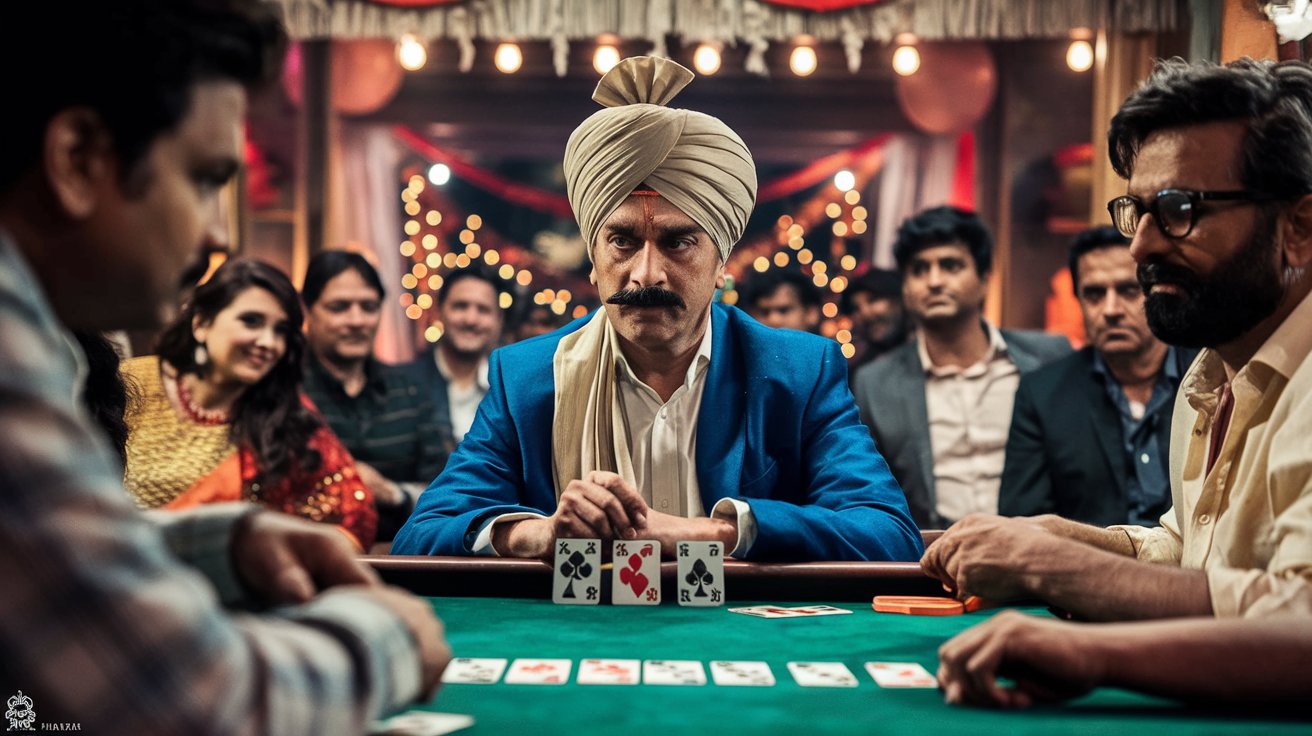In the vast landscape of Indian cinema, certain cultural elements consistently find their way onto the silver screen, reflecting the authentic fabric of daily life. Among these, card games—particularly rummy—have featured prominently, often serving as powerful storytelling devices. From high-stakes dramatic showdowns to lighthearted family gatherings, rummy scenes in Indian movies transcend mere gameplay to become pivotal moments that advance plots, reveal character traits, and sometimes even change destinies.
This deep-rooted connection between rummy and Indian cinema isn’t coincidental. It mirrors the game’s significant cultural position in Indian society, where rummy has long been more than just a pastime—it’s a social institution that brings families together during festivals, friends during casual gatherings, and even strangers in moments of shared entertainment. Let’s shuffle through some of the most memorable rummy moments in Indian cinema and explore how this seemingly simple card game has been transformed into an art form by filmmakers across different languages and eras.
The Dramatic Stakes: Rummy as Plot Device
The High-Stakes Games That Changed Everything
Indian cinema has frequently used rummy games as pivotal plot points where fortunes—and sometimes lives—hang in the balance. These scenes typically showcase the game’s potential for creating extreme tension and dramatic reversals.
In the 1975 Bollywood classic “Sholay,” while not explicitly a rummy game, the card playing scenes between Amjad Khan’s iconic villain Gabbar Singh and his henchmen establish power dynamics that resonate throughout the film. The casual way in which life-and-death decisions are made over card games creates a chilling portrayal of villainy that has become legendary in Indian cinema.
The 2006 Tamil thriller “Vettaiyaadu Vilaiyaadu” features a memorable rummy sequence where Kamal Haasan’s character, a police officer, engages criminals in a game while gathering critical information. The scene brilliantly uses rummy as both a tension-building mechanism and a metaphor for the larger cat-and-mouse game between cop and criminals.
“Teen Patti” (2010), while focusing on another card game, draws many parallels to rummy culture and features Amitabh Bachchan as a mathematics professor developing a theory on probability through card games. Though not strictly about rummy, the film captures the intellectual and strategic elements that make card games so compelling on screen.
When Life Imitates Cards: Symbolic Rummy Moments
![]()
More nuanced filmmakers have employed rummy as powerful symbolism, where the game’s mechanics mirror the characters’ life situations.
The acclaimed Malayalam film “Chithram” (1988) features a scene where Mohanlal’s character engages in a rummy game that serves as a microcosm for his larger predicament—needing to maintain appearances while hiding significant secrets, much like concealing valuable cards while appearing nonchalant.
In the Telugu drama “Gamyam” (2008), a roadside rummy game becomes a turning point where the protagonist realizes the random nature of opportunity and privilege—some are dealt better hands than others through no merit of their own, a realization that transforms his worldview.
The 2012 Hindi film “Gangs of Wasseypur” uses a tense card game scene to illustrate power dynamics between rival gang members, with rummy serving as a civilized veneer barely concealing murderous intentions. Director Anurag Kashyap masterfully employs the visual language of card playing—quick glances, false tells, strategic discards—to foreshadow the violence that follows.
The Comedy Card: Rummy Scenes That Sparked Laughter
The Bumbling Player Trope
Indian comedy films have found endless humor in rummy games, often through characters who are hilariously bad at the game yet remain blissfully confident in their skills.
The Tamil comedy “Malamaal Weekly” (2006) features a village rummy game that descends into absolute chaos when a lottery ticket becomes mixed with the playing cards. The ensuing confusion creates one of the film’s most memorable comedic sequences.
Legendary comedian Mehmood’s films often featured rummy games where his characters would employ outlandish cheating methods, creating physical comedy gold. In “Bombay to Goa” (1972), his character’s attempts to peek at other players’ cards while pretending to retrieve dropped items became a template for similar comedy scenes for decades to come.
The more recent “Golmaal” series frequently uses card games as a backdrop for the main characters’ ridiculous antics and rapid-fire banter, with rummy sessions serving as a convenient setting for showcasing the ensemble cast’s comedic chemistry.
Clever Cons and Rummy Hustlers

A popular subset of comedy scenes involves clever players outwitting opponents through ingenious (if unethical) means.
The 1979 classic “Gol Maal” (not to be confused with the newer franchise) includes a scene where Amol Palekar’s character uses a rummy game to create an alibi—a clever use of the game as both comic relief and plot device.
In “Munna Bhai M.B.B.S.” (2003), though not strictly rummy, the card games played in the hospital showcase Sanjay Dutt’s character using his street smarts to connect with patients, creating moments of both humor and unexpected emotional depth.
The Malayalam film “Kilukkam” (1991) features Mohanlal in a hilarious sequence where his character pretends to be a novice rummy player before revealing his expertise, using the game to outsmart a group of swindlers at their own game.
Family Bonds: Rummy as Social Glue
Festive Gatherings and Rummy Traditions
Perhaps the most authentic depictions of rummy in Indian cinema are the countless scenes of family gatherings where the game serves as a centerpiece for interaction and bonding.
The Tamil family drama “Anbe Sivam” (2003) uses a rummy game to reveal character dynamics within a family, with playing styles reflecting personalities: the conservative father who plays by the book, the risk-taking son, and the mother who secretly has the best strategy of all.
In “2 States” (2014), a rummy game during a family gathering becomes the stage for culture clash between North and South Indian families, humorously highlighting regional differences while ultimately showing the universal language of play that brings people together.
The Malayalam film “Bangalore Days” (2014) features a heartwarming sequence where family members across generations connect through a lively rummy game, illustrating how the card game serves as a bridge across age gaps.
Women and Rummy: Breaking Stereotypes
Indian cinema has also captured how rummy games sometimes serve as spaces where traditional gender roles are temporarily suspended, with women displaying strategic brilliance and competitive spirit.
The 2007 Bollywood film “Laaga Chunari Mein Daag” includes a scene where women of the household engage in a rummy game, using the seemingly innocent setting to exchange crucial information and make important decisions away from male oversight.
In the Tamil film “36 Vayadhinile” (2015), Jyothika’s character’s skill at rummy symbolizes her hidden capabilities that extend far beyond her perceived role as just a homemaker, becoming a subtle metaphor for her journey toward self-actualization.
The recent anthology “Lust Stories” (2018) features a scene where a household help joins her employer in a rummy game, creating a temporary space where class boundaries blur—until social reality inevitably reasserts itself when the game ends.
Regional Flavors: How Different Film Industries Portray Rummy
South Indian Cinema’s Rummy Obsession
The South Indian film industries—Tamil, Telugu, Malayalam, and Kannada—have particularly embraced rummy scenes, reflecting the game’s enormous popularity in the region.
Malayalam cinema often portrays rummy as an intellectual pursuit, with dialogue-heavy scenes where characters engage in philosophical conversations while playing. The cult classic “Manichitrathazhu” (1993) uses a card game to establish the psychiatric brilliance of Mohanlal’s character, who analyzes other players’ psychological tells.
Tamil films frequently depict village-level rummy circles as centers of gossip and information exchange. In “Thevar Magan” (1992), Kamal Haasan’s landmark film, a village card game serves as an exposition device where the audience learns crucial background information through seemingly casual banter over cards.
Telugu mass entertainers often feature heroes who display their cleverness through exceptional rummy skills. In films like “Pokiri” (2006), the protagonist’s card game prowess becomes a metaphor for his strategic mind and ability to outwit opponents.
Bollywood’s Evolution of Card Game Depictions

Hindi cinema’s portrayal of rummy and card games has evolved significantly over decades, reflecting changing social attitudes.
In older films like “Sholay” (1975) and “Deewaar” (1975), card games were often associated with morally ambiguous characters or outright villains, reflecting a time when gambling carried stronger social stigma.
By the 1990s, films like “Hum Aapke Hain Koun..!” (1994) were showing card games as innocent family entertainment, with rummy scenes between extended family members portraying the changing social attitudes toward the game.
Modern Bollywood films like “Kal Ho Naa Ho” (2003) and “Yeh Jawaani Hai Deewani” (2013) feature rummy as a sophisticated social activity, often played in upscale settings with friends rather than family, reflecting urban India’s evolving relationship with traditional games.
Technical Brilliance: How Directors Film Rummy Scenes
The Visual Language of Card Games
Filming card games presents unique challenges that have pushed Indian directors to develop innovative visual techniques.
The legendary Tamil director Mani Ratnam pioneered distinctive card game cinematography in films like “Thalapathi” (1991), using extreme close-ups of eyes and hands to create suspense, a technique that influenced countless filmmakers across industries.
Malayalam filmmaker Lijo Jose Pellissery’s “Angamaly Diaries” (2017) features a dynamic rummy scene shot in a single take, with the camera weaving between players, creating an immersive experience that pulls viewers directly into the game’s energy.
In “Gangs of Wasseypur” (2012), director Anurag Kashyap uses rummy scenes to showcase his technical prowess, with rapid editing between faces, cards, and hands creating a rhythm that builds incredible tension despite the seemingly mundane activity.
Sound Design and Music in Rummy Moments
The auditory experience of rummy scenes has received surprisingly sophisticated treatment in Indian cinema.
A.R. Rahman’s background score during the card sequences in “Guru” (2007) subtly intensifies, with the tempo matching the increasing stakes of the game—a masterclass in how music can elevate a simple card game to dramatic heights.
The Malayalam film “Maheshinte Prathikaaram” (2016) takes the opposite approach, using near silence during a crucial rummy scene, with only the ambient sounds of cards shuffling and being placed down, creating an atmosphere of intense concentration that draws viewers in.
Telugu blockbusters often employ percussion-heavy background scores during rummy sequences, particularly when the hero makes a winning move, turning simple card placement into epic moments worthy of mass celebration.
Cultural Impact: When Cinema Influences Real-Life Rummy
The Celebrity Effect on Rummy Popularity
The portrayal of rummy in popular films has significantly influenced its cultural status and popularity.
After Rajinikanth’s character displayed impressive rummy skills in “Baashha” (1995), card game clubs in Tamil Nadu reported increased interest, with many players attempting to mimic the superstar’s distinctive card-holding style and flourishes.
The portrayal of strategic rummy play in the 2006 cricket-themed film “Iqbal” led to increased interest in the mathematical and probabilistic aspects of the game, with players becoming more interested in the skill elements rather than just the social component.
Online rummy platforms have capitalized on this connection, with many featuring advertisements that reference iconic movie scenes or employ film celebrities as brand ambassadors, leveraging cinema’s cultural influence.
Dialogue That Transcended the Screen
Certain lines spoken during film rummy scenes have entered everyday language, used by real players during actual games.
The oft-quoted line from “Sholay” (1975), “Kitne aadmi the?” (“How many men were there?”) is playfully referenced in real-life card games when asking how many cards a player needs to complete their set.
Mohanlal’s iconic dialogue from “Kilukkam” (1991) about maintaining the perfect poker face—”Chiri varumbol chirikkaruthu, karayaan thonnumbol karayaruthu” (“Don’t laugh when you feel like laughing, don’t cry when you feel like crying”)—has become advice passed down to new rummy players across Kerala.
The Telugu film “Ready” (2008) gave birth to numerous catchphrases that players use to announce their moves in real-life rummy games, showing how deeply film references have penetrated actual gameplay.
Conclusion: The Enduring Marriage of Rummy and Indian Cinema
The relationship between rummy and Indian cinema is reciprocal—movies reflect the game’s cultural significance while simultaneously enhancing and reshaping its position in society. Directors across various Indian film industries continue to find new ways to use this seemingly simple card game as a storytelling device of remarkable versatility.
Whether as high-stakes drama, comedic backdrop, family bonding ritual, or symbolic parallel to life itself, rummy in Indian movies transcends its status as mere gameplay to become a cultural touchstone. These iconic scenes and moments capture something essential about Indian society—the value placed on strategic thinking, social connection, and the perfect blend of skill and chance that mirrors life’s own unpredictable journey.
As Indian cinema continues to evolve, rummy’s presence on screen seems assured. After all, few activities offer such rich possibilities for drama, comedy, character revelation, and social commentary while remaining so authentically rooted in the everyday experiences of audiences across the nation. The cards may change with each deal, but rummy’s place in the creative deck of Indian filmmakers remains a winning hand that they’ll likely continue to play for generations to come.

Zareb Saleh is a journalist at Gulf Today and a ghostwriter for Gameoholic, specializing in gaming, technology, and digital culture. With a keen eye for industry trends, he delivers insightful stories that engage and inform readers.



